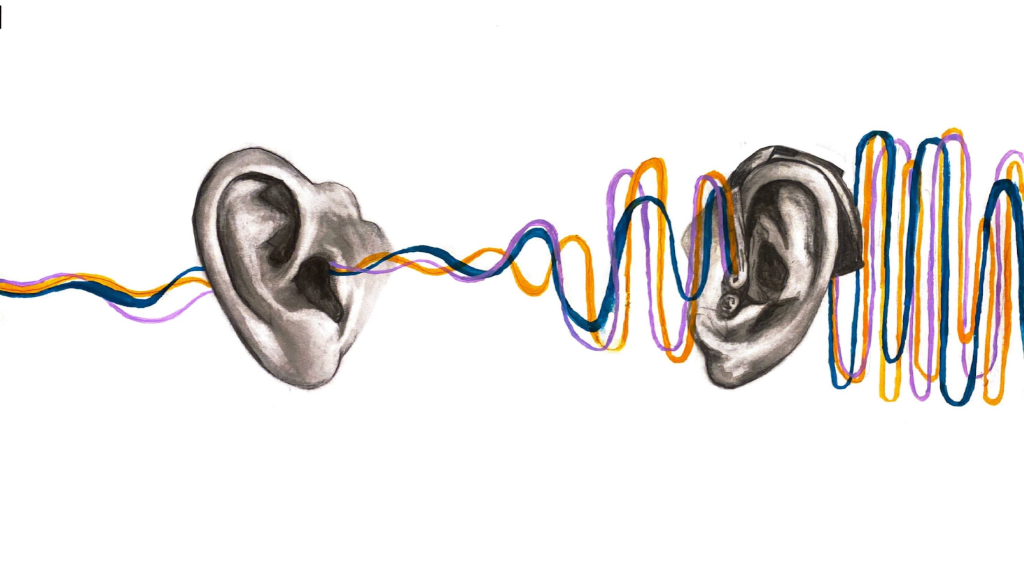Deafness is a spectrum, as all Deaf people are different and identify themselves in their own way. The selective capitalization of the term is a prominent example — some individuals identify as deaf with a lowercase “d,” whereas others go by capital “D” Deaf. It is important to use the preferred form when describing Deaf person in writing, but many remain unfamiliar with these two identifications of Deafness.
WHAT’S THE DIFFERENCE?
Last semester Malvana Ramborger, a fourth year Illustrative Design student at RIT, described the difference between these seemingly similar forms.
“Capital ‘D’ Deaf is really for people that have grown up fully immersed in Deaf culture,” she noted. “Typically, those who have more than two generations of Deaf people in their family, who have gone to Deaf schools, are immersed in Deaf culture and are proud of their culture as well.”
Ramborger believes that capital “D” Deaf individuals see their Deafness in a cultural context and as an integral piece of their identity, rather than a medical condition that needs to be cured.
“For lowercase ‘d,’ they don’t really have that strong of a bond. They’ve heard about what it is, but they’re not fully immersed in Deaf culture.”
David Zhao, a third year Accounting student, agreed with Ramborger that the capitalization of Deaf refers to one’s ability to identify with Deaf culture.
“There’s a spectrum connecting Deaf identity, Deaf community, and cultural development,” he signed. “So for capital ‘D,’ you grew up connecting with the Deaf community and going to a Deaf school. You’re proud to be Deaf [and] who you are, and so you have a strong connection with the Deaf community.”
"A lot of people that go to RIT sometimes don't really have an identity yet."
However, Zhao then explained that hard-of-hearing (HoH) individuals are often listed under the lowercase “d” category, though both identities retain familial, educational and cultural connections to Deafness.
“Lowercase ‘d’ is more for you if you’re hard of hearing, or not fully deaf. Maybe not as connected with the Deaf community. Maybe you didn’t go to the Deaf institution, or were in a mainstream school of hearing students as well,” signed Zhao.
Despite any variations in definitions, the decision to capitalize the term (or even use it at all) must be left to the individual. It is a personal preference to even want to identify using either at all.
CHOOSING LOWERCASE OR UPPERCASE
Most often, Deaf people choose their preferred form based on how they grew up. However, similar to other aspects of identity, what makes individuals most comfortable may gradually change over time.
For example, while Ramborger identified as capital “D” Deaf as she grew up and attended a Deaf school, she now uses both forms after interacting with more individuals outside the Deaf community.
“I’ve been hanging out with hearing people and Deaf people,” she mentioned. “I’ve also experienced interacting with a lot of different people on the spectrum of capital ‘D’ and lowercase ‘d,’ so I would say I’m about in the middle.”
Zhao has jumped back and forth but, like Ramborger, currently identifies in the middle following childhood experiences with both hearing and Deaf education.
“For eight years, I was in a mainstream school, elementary school to seventh grade,” Zhao signed. “So I socialized with hearing students and hearing people and was kind in that environment for a while until eighth grade. Then I transferred to a Deaf school for high school.”
IMPORTANCE OF IDENTITY
Coming to terms with identity is especially important for many Deaf people, which is why others need to respect the preferences of those who wish to use a particular form of D/deaf.
“I think it’s very important,” Ramborger explained. “It’s a big part of my life. I’m a third-generation Deaf [person] and my family has gone to Deaf schools, and ASL is my first language as well. I love being Deaf. I couldn’t imagine it any other way. It’s a life of silence.”
Regardless of how she identifies, Ramborger still enjoys socializing with all RIT students regardless of her or other people’s hearing status. In fact, coming to RIT often helps Deaf students find their identity, as many have previously never been surrounded by a Deaf community.
"Lowercase 'd' is more for you if you're hard of hearing, or not fully deaf. Maybe not as connected with the deaf community."
“A lot of people that go to RIT sometimes don’t really have an identity yet,” she said. “And as they go to RIT, they eventually find their identity.”
Although capital “D” Deaf and lowercase “d” deaf are two important forms of identity within the Deaf community, they are not the only ones. Alberta Hands & Voices, an advocacy group for Deaf and HoH children, uses Deaf Plus (Deaf+) to describe children with “hearing loss in addition to other conditions that affect them medically, physically, emotionally, educationally, or socially.”
This generally includes learning disabilities, ADD/ADHD, vision loss, cerebral palsy and autism. It is important to note that Deaf+ individuals are likely to experience more discrimination compared to others, though the Deaf community as a whole is often still oppressed.
Moreover, many historical terms used to identify Deaf individuals are now considered derogatory and have since been discontinued. Phrases such as “deaf and dumb,” “deaf-mute,” and “hearing impaired” are no longer used to describe members of the Deaf community.
Regardless of your identity, please remember to stay safe and respect those around you. It is a privilege to publicly identify as you wish, as society has stripped that choice from Deaf people for many years.








